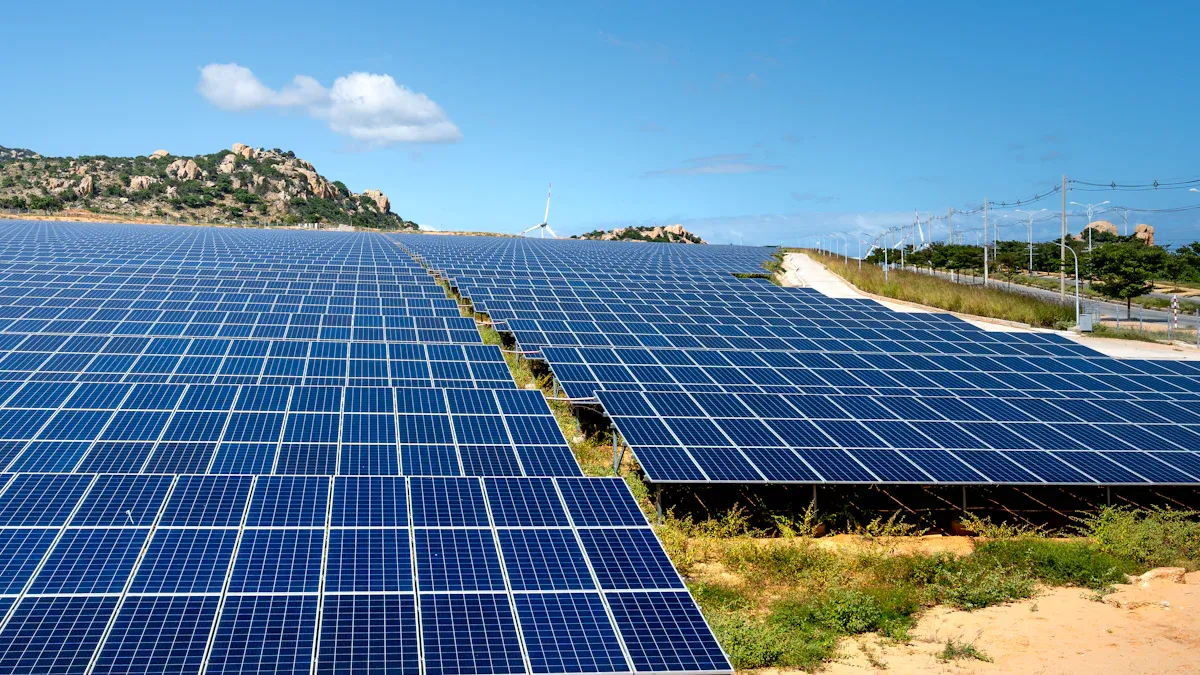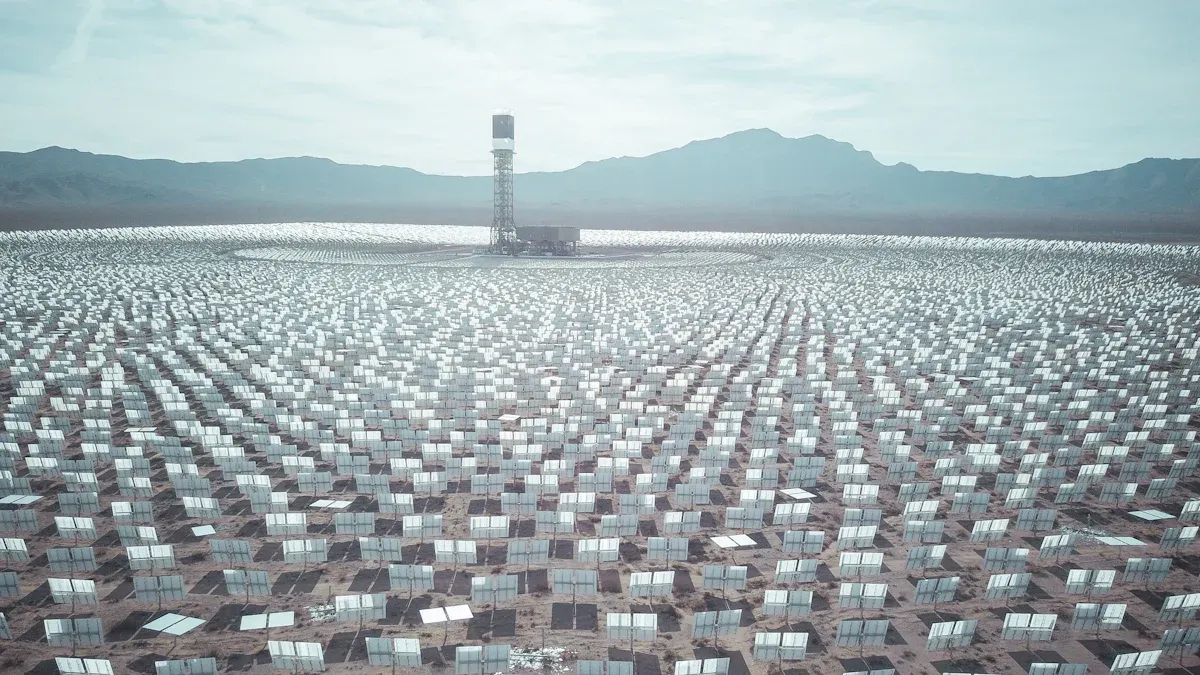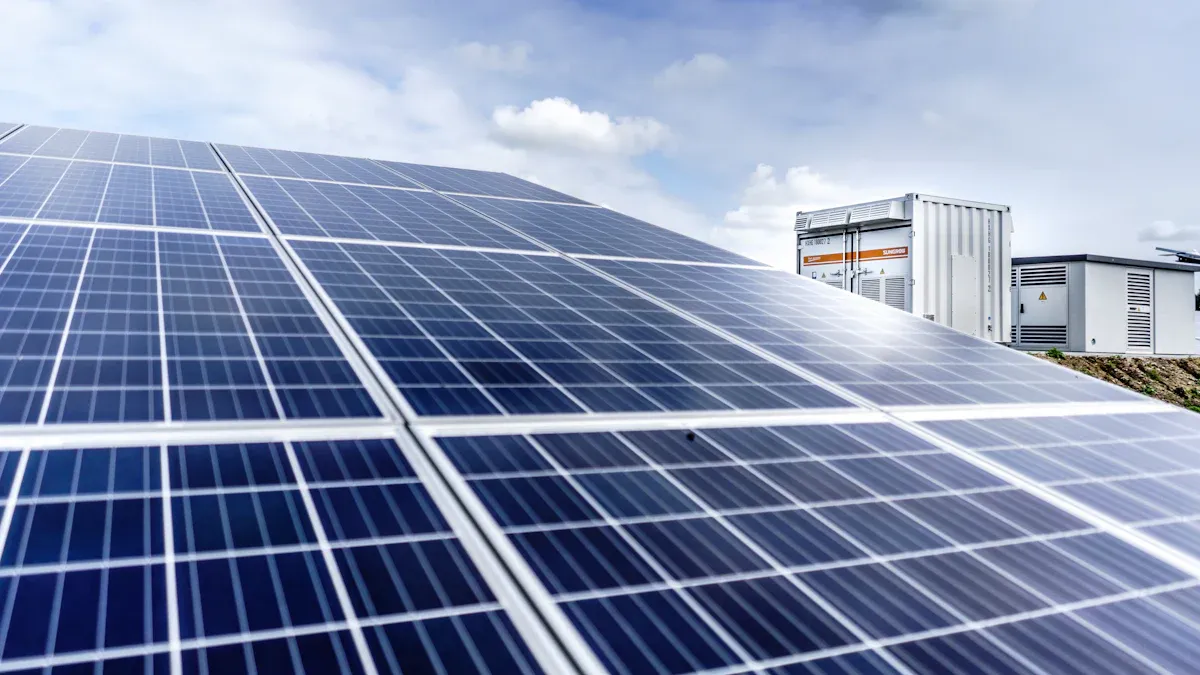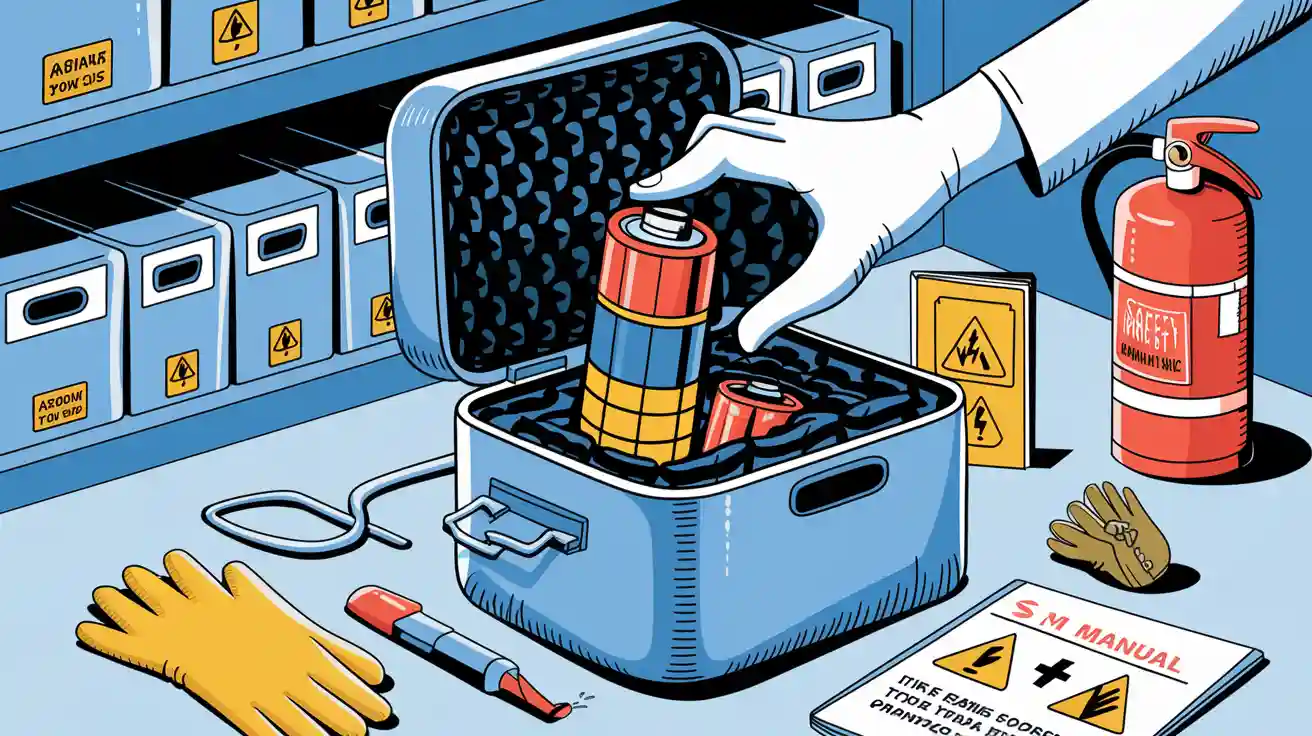Contents

When it comes to batteries for solar power storage, choosing the right battery can make or break your system’s performance. Lithium-ion and lead-acid batteries differ significantly in how they store and deliver energy. Lithium-ion batteries offer a longer lifespan, lasting 2000 to 5000 cycles, compared to lead-acid batteries, which typically last up to 1000 cycles. They also handle deeper discharges—up to 85%—without damage, while lead-acid batteries struggle beyond 50%. This means lithium-ion batteries can store more energy in a smaller size, making them ideal for modern solar panel setups.
Selecting the right batteries for solar power storage ensures your solar energy system meets your energy needs efficiently. A battery with higher capacity and efficiency minimizes energy losses and keeps your home powered during cloudy days or at night. By understanding these differences, you can make a smarter choice for your solar energy goals.
Key Takeaways
Lithium-ion batteries last longer, with 2,000 to 5,000 uses. Lead-acid batteries only last up to 1,000 uses.
Pick lithium-ion batteries for better efficiency (90-95%) and deeper use (up to 85%). This helps you use more energy.
Lead-acid batteries cost less at first but need replacing often. This makes them more expensive over time.
Think about how much energy you need and how much space you have before choosing a battery.
Lithium-ion batteries are easier to care for and last longer. They are a smarter choice for the future.
Overview of Batteries for Solar Power Storage

When it comes to solar battery storage, understanding the different battery types is essential. Each type has unique characteristics that make it suitable for specific applications. Here’s a closer look at two of the most common options: lithium-ion batteries and lead-acid batteries.
Lithium-ion Batteries
Lithium-ion batteries are a popular choice for solar power storage, and for good reason. They pack a lot of energy into a small, lightweight package, making them ideal for residential and commercial systems. These batteries offer several advantages:
High energy density: They store more power in less space, which is perfect if you have limited room.
Long lifespan: With a typical lifespan of 5 to 20 years, they provide excellent value over time.
High efficiency: Lithium batteries boast a round-trip efficiency of 90-95%, meaning you get more usable energy from what you store.
Minimal maintenance: Unlike other battery types, they require little to no upkeep.
These features make lithium-ion batteries a reliable and efficient option for modern solar energy systems. However, their higher upfront cost can be a drawback for some users.
Lead-acid Batteries
Lead-acid batteries are one of the oldest and most affordable technologies for solar power storage. They are often used in small DIY solar setups or backup systems. Here’s what you should know about them:
Lower upfront cost: They are budget-friendly, making them accessible for those just starting with solar energy.
Idle capability: These batteries can remain unused for long periods without significant degradation.
Maintenance: While they require some care, such as checking water levels, they are manageable for most users.
However, lead acid batteries have limitations. They are bulky, have a lower energy density, and should only be discharged to 50% of their capacity to maintain their lifespan. This makes them less efficient and durable compared to lithium batteries.
Battery Type | Characteristics | Applications | Lifespan | Energy Density |
|---|---|---|---|---|
Lead-acid | Oldest and cheapest technology; bulky | Small DIY solar installations | 3 to 7 years | Low-density, bulky |
Lithium-ion | High energy density; minimal maintenance | Residential and commercial storage | 5 to 20 years | Dense and compact |
Both battery types have their strengths and weaknesses. Your choice will depend on your budget, energy needs, and how much maintenance you’re willing to handle.
Key Comparison Factors
Capacity and Energy Density
When choosing batteries for solar power storage, capacity and energy density are critical factors. These determine how much energy your battery can store and how compact it is. Lithium-ion batteries shine in this area. They offer an energy density of 150 to 200 Wh/kg, which means they store more energy in less space. This makes them perfect for installations where space is limited. On the other hand, lead acid batteries lag behind with an energy density of just 30 to 50 Wh/kg. You’d need more lead-acid batteries to match the storage of fewer lithium-ion ones.
Another advantage of lithium-ion batteries is their ability to handle deeper discharges. You can safely use up to 85% of their capacity without damaging them. Lead acid batteries, however, should only be discharged to 50% to maintain their lifespan. This difference means lithium batteries provide higher battery capacity and better energy utilization.
Tip: If you’re tight on space or need more energy storage, lithium-ion batteries are the way to go.
Efficiency and Performance
Battery efficiency directly impacts how much of your stored solar energy you can actually use. Lithium-ion batteries boast an impressive efficiency of over 95%. For every 1,000 watts of solar power stored, you can access at least 950 watts. Lead acid batteries, in contrast, operate at 80-85% efficiency, meaning more energy is lost during storage and retrieval.
Performance under varying conditions also sets these two apart. Lithium-ion batteries deliver consistent power and charge quickly—up to 80% in just 30 minutes. Lead acid batteries take much longer, often requiring 8-16 hours for a full charge. They also struggle to maintain stable power delivery over time.
Metric | Lithium-Ion Batteries | Lead-Acid Batteries |
|---|---|---|
Charging Speed | 80% in 30 minutes | 8-16 hours |
Depth of Discharge | Up to 85% | Limited to 50% |
Power Delivery | Consistent and stable | Decreases over time |
Cost and Affordability
Cost is often a deciding factor when selecting batteries for solar power storage. Lead acid batteries are more affordable upfront, costing around $100 to $200 per kWh. This makes them appealing for budget-conscious users. Lithium-ion batteries, however, come with a higher price tag, ranging from $300 to $500 per kWh. While the initial investment is steeper, their longer lifespan and higher efficiency can save you money in the long run.
Battery Type | Upfront Cost (per kWh) | Advantages |
|---|---|---|
Lead-Acid | $100 – $200 | Lower upfront cost, widely available |
Lithium-Ion | $300 – $500 | Longer lifespan, better efficiency |
Note: If you’re planning for long-term use, lithium-ion batteries may offer better value despite their higher initial cost.
Lifespan and Durability
When it comes to battery life, lithium-ion batteries clearly outshine lead acid batteries. Lithium batteries typically last between 5 and 15 years, depending on usage and maintenance. They can handle 2,000 to 5,000 charge-discharge cycles, which translates to about 5.5 to 13.7 years of reliable performance. In contrast, lead acid batteries usually last 3 to 10 years, but many fall short of this range. Most lead-acid batteries only manage up to 1,000 cycles, meaning you might need to replace them three times over a 10-year period to match the lifespan of a single lithium battery.
Durability is another area where lithium-ion batteries excel. They allow a depth of discharge (DoD) of up to 95%, letting you use more of the stored energy without damaging the battery. Lead acid batteries, on the other hand, should only be discharged to 50% to avoid reducing their lifespan. This difference makes lithium batteries a better choice for long-term solar energy storage.
Feature | Lithium-Ion Batteries | Lead-Acid Batteries |
|---|---|---|
Lifespan | 5 to 15 years | 3 to 10 years |
Charge-Discharge Cycles | 2,000 to 5,000 | Up to 1,000 |
Depth of Discharge | Up to 95% | Limited to 50% |
Tip: If you want a longer lifespan and better durability, lithium-ion batteries are worth the investment.
Maintenance Requirements
Maintenance is another key factor to consider. Lithium-ion batteries require minimal upkeep. You only need to ensure proper charging and use protection circuits to prevent overcharging. This simplicity makes them a hassle-free option for solar energy systems. Lead acid batteries, however, demand regular attention. You’ll need to monitor electrolyte levels and top up distilled water to prevent sulfation, which can reduce their capacity over time.
The higher maintenance needs of lead acid batteries can also increase their overall cost. Frequent upkeep and replacements mean more downtime and expenses. Lithium batteries, with their lower maintenance requirements, save you time and money in the long run.
Note: If you prefer a low-maintenance solution, lithium-ion batteries are the way to go.
Environmental Impact
Both battery types have environmental pros and cons. Lithium-ion batteries don’t contain toxic heavy metals like lead, making them less harmful during use. However, the extraction of lithium can cause significant environmental damage. Mining activities often deplete water reserves and pollute the soil, as seen in Bolivia’s salt desert. Proper disposal is also crucial to avoid long-term environmental issues.
Lead acid batteries, on the other hand, are highly recyclable, with a recycling rate of 99%. But they pose serious health risks due to lead exposure during mining, processing, and recycling. This makes their environmental impact a double-edged sword. While recycling reduces waste, improper handling can lead to contamination and health hazards.
Battery Type | Environmental Impact |
|---|---|
Lithium-Ion | No toxic heavy metals; mining causes water depletion and soil pollution |
Lead-Acid | 99% recyclable; lead exposure poses health and environmental risks |
Reminder: Consider the environmental impact of your battery choice, especially if sustainability is a priority for you.
Suitability for Solar Energy Applications
Off-grid Solar Systems
If you’re setting up an off-grid solar system, choosing the right battery is crucial. Lithium-ion batteries are often the go-to option here. Why? They’re incredibly efficient, with over 95% of the stored energy being usable. In contrast, lead-acid batteries fall below 80%, meaning more energy gets wasted. Plus, lithium-ion batteries can handle deep discharges of 80% or more, letting you use more of their capacity. Lead-acid batteries, on the other hand, need to stay above 50% to avoid damage.
Battery Type | Efficiency |
|---|---|
Lithium-ion | > 95% |
Lead-acid | < 80% |
Lithium-ion batteries also pack more energy into a smaller, lighter design. This makes them easier to install and ideal for remote locations where space and weight matter. Their faster charging times mean you can quickly replenish your energy supply, even on cloudy days. If you’re looking for reliability and performance in an off-grid setup, lithium-ion batteries are hard to beat.
Backup Power Systems
For backup power systems, lead-acid batteries might be a better fit, especially if you’re on a budget. They have a lower upfront cost, making them practical for emergency setups. Sealed lead-acid batteries, like AGM or Gel types, require minimal maintenance. They’re perfect for systems that don’t cycle often, such as backup power for homes or properties you don’t visit regularly.
Lower upfront cost makes them affordable for emergency use.
They can remain idle for long periods without significant degradation.
If you need a cost-effective solution for occasional use, lead-acid batteries are worth considering.
Industrial and Large-scale Applications
For industrial or large-scale solar energy systems, lithium-ion batteries shine. Their high energy density and compact design allow them to store large amounts of energy without taking up much space. They also deliver exceptional efficiency, with a round-trip efficiency of 90-95%. This means you get more usable energy for every watt stored.
Lithium-ion batteries also have a long lifespan, often exceeding eight years, making them a solid investment. Their fast response time ensures rapid power delivery, which is critical for industrial operations. With the market for lithium-ion batteries expected to grow to over $17 billion by 2028, their declining costs make them an increasingly attractive option for large-scale applications.
Tip: If you’re planning a large-scale project, lithium-ion batteries offer the best combination of efficiency, durability, and long-term value.
Pricing and Long-term Cost Analysis

Upfront Costs
When it comes to upfront costs, lead-acid batteries are the more affordable option. You can expect to pay between $100 and $200 per kWh for lead-acid batteries, making them a budget-friendly choice for smaller solar setups. Lithium-ion batteries, on the other hand, come with a higher price tag, ranging from $300 to $500 per kWh. This difference can feel significant, especially if you’re just starting out with solar energy.
However, the higher initial investment in lithium-ion batteries often pays off in the long run. Their advanced technology, higher efficiency, and longer lifespan justify the cost. If you’re planning for a system that will last for years, it’s worth considering how this upfront expense balances out over time.
Lifecycle Costs
While lead-acid batteries may seem cheaper initially, their lifecycle costs tell a different story. These batteries typically last up to 1,000 cycles, which means you might need to replace them every 2-3 years. Over a 10-year period, you could end up replacing lead-acid batteries three times. In contrast, lithium-ion batteries can handle 2,000 to 5,000 cycles, lasting 5.5 to 13.7 years with daily use. This longevity reduces the need for frequent replacements, saving you money and hassle.
Lithium-ion batteries also require less maintenance. Lead-acid batteries need regular checks and water refills, which can add to your overall costs. By choosing lithium-ion, you avoid these extra expenses and enjoy a more reliable system.
Tip: If you’re looking for a long-term solution, lithium-ion batteries offer better value despite their higher upfront cost.
Return on Investment (ROI)
Your return on investment depends on several factors, including efficiency, lifespan, and maintenance. Lithium-ion batteries allow deeper discharges (up to 85%) and have higher efficiencies (95% or greater). This means you can use more of the stored energy, reducing your dependence on grid electricity and saving money over time. Lead-acid batteries, with their 50% depth of discharge and 80-85% efficiency, fall short in this area.
Federal solar technology credits can also impact your ROI. With these incentives, you might break even in about ten years. Without them, it could take closer to 13 years. Lithium-ion batteries, with their longer lifespan and lower maintenance needs, make it easier to achieve a positive ROI. They also open up opportunities for additional income through energy trading or demand response programs.
Aspect | Lead-Acid Batteries | Lithium Batteries |
|---|---|---|
Initial Cost | $10,000 | $15,000 |
Lifespan | 5 years | 10 years |
Replacement Frequency | 2 replacements/year | 0.5 replacements/year |
Depth of Discharge (DoD) | 50% | 80% |
Reminder: While lead-acid batteries have a lower battery cost upfront, lithium-ion batteries provide better long-term savings and reliability.
Choosing between lithium-ion and lead-acid batteries depends on your priorities. Here’s a quick recap:
Lead-acid batteries are cheaper upfront but less efficient (80%) and have a shorter lifespan (under 1,000 cycles).
Lithium-ion batteries cost more initially but offer higher efficiency (over 90%), longer life (2,000–5,000 cycles), and better energy density.
To make the right choice:
Understand Your Power Needs: Calculate your energy usage and storage requirements.
Weigh Costs vs. Longevity: Consider upfront costs and long-term savings.
Match Battery Type to Application: Use lithium-ion for efficiency and durability or lead-acid for budget-friendly setups.
Tip: If you want a low-maintenance, long-term solution, lithium-ion batteries are worth the investment.





